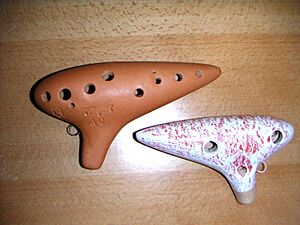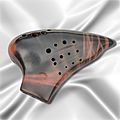Ocarina facts for kids
An ocarina is a special type of flute. Unlike most flutes, it isn't a long tube. Instead, ocarinas are often shaped like a round egg or a small box. This unique shape gives the ocarina a sound that's a bit different from other flutes. It's a fun instrument to play!
Contents
A Look Back in Time: The Ocarina's History
People have been making instruments like the ocarina for a very long time, even hundreds of years ago! These early versions were found in places like South America, China, and Africa.
In Europe, during the 1500s, there was an instrument called the gemshorn. It was similar to an ocarina but was made from an animal horn.
The Modern Ocarina is Born
The ocarina we often see today, with ten holes, was first created in Italy in 1853. A man named Giuseppe Donati invented it.
In the 1800s, groups of musicians started playing ocarinas together. They used different sized ocarinas to play classical songs and folk music. Because of these groups, Italian ocarinas became famous all over the world!
Ocarinas Around the World
In the United States, some people called the ocarina a "sweet potato." Can you guess why? It was because its shape looked a lot like a sweet potato!
Later, in 1928, people in Japan started making ocarinas. They made a cool change: they added two more holes to the older ten-hole design. This new 12-hole Japanese ocarina could play even more notes!
The English Ocarina
In the 1960s, a new type of ocarina was invented in England. It's called the English ocarina. This version usually has four holes for your fingers and sometimes one or two holes for your thumbs. English ocarinas come in many different shapes and sizes, making them quite unique!
Images for kids
-
Sindhi borrindos, a type of vessel flute from the Indus Valley. They are made from soft clay.
See also
 In Spanish: Ocarina para niños
In Spanish: Ocarina para niños






















